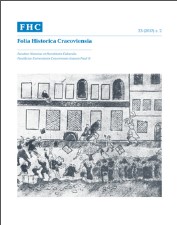Widzialny znak niewidzialnej łaski. Tzw. komplet żywiecki w skarbcu katedry na Wawelu w świetle badań źródłowych i ikonograficznych
A visible sign of invisible grace. The so-called Żywiec ensemble in the treasury of the Wawel Cathedral in light of source and iconographic studies
Author(s): Szymon TraczSubject(s): Christian Theology and Religion, Cultural history, History of Church(es), 16th Century, History of Art
Published by: Wydawnictwo Naukowe Uniwersytetu Papieskiego Jana Pawła II w Krakowie
Keywords: chasuble; liturgical vestments; embroidery; brocade; seven sacraments; sacrament; christening; confirmation; Holy Communion; anointing of the sick; penance; holy orders; matrimony; devotio moderna;
Summary/Abstract: An exceptional place among liturgical vestments in the Treasury of the Wawel Cathedral occupies an ensemble consisting of a chasuble and two dalmatics, referred to as the ‘Żywiec ensemble’ (Treasury of the Wawel Cathedral, chasuble – inv. no. KKK tk/334, a dalmatic depicting the Holy Communion – KKK tk/334A, a dalmatic depicting the Confession – KKK 334B). The vestments were sewn from Italian brocade around 1525 in Flanders and ornately decorated with figurative embroidery according to a design attributed to Lucas van Leyden (d. 1533). Since 1598 archival sources explicitly link the Żywiec ensemble to the parish church of the Nativity of the Blessed Virgin Mary in Żywiec (currently the co-cathedral of the Bielsko-Biała/Żywiec diocese), which precludes the possibility of a later transfer or any purchase of the ensemble. The exceptional character of the vestments from Żywiec is emphasized by implementation of an ideological programme referring to the administration of the holy sacraments. Only a few examples of European liturgical vestments decorated with images of the seven sacraments are extant – e.g. in St. Vincent Collegiate Church in Soignies (Zinnik) from late 15th century, on the band of a no longer extant cope of 1470 founded by count Giacomo de Savoia-Romont (Bern, Bernisches Historisches Museum, inv. 308), on embroideries of a Flanders cope from the end of the 15th century (Detroit, Institute of Arts), although we may encounter instances of such images in other fine arts, in particular in 15th century Dutch art: wall paintings, stained-glass paintings, book illustrations, sculptures (esp. font decorations) or many surviving sculpted or painted altarpieces and tapestries.
Journal: Folia Historica Cracoviensia
- Issue Year: 23/2017
- Issue No: 2
- Page Range: 427-464
- Page Count: 38
- Language: Polish

